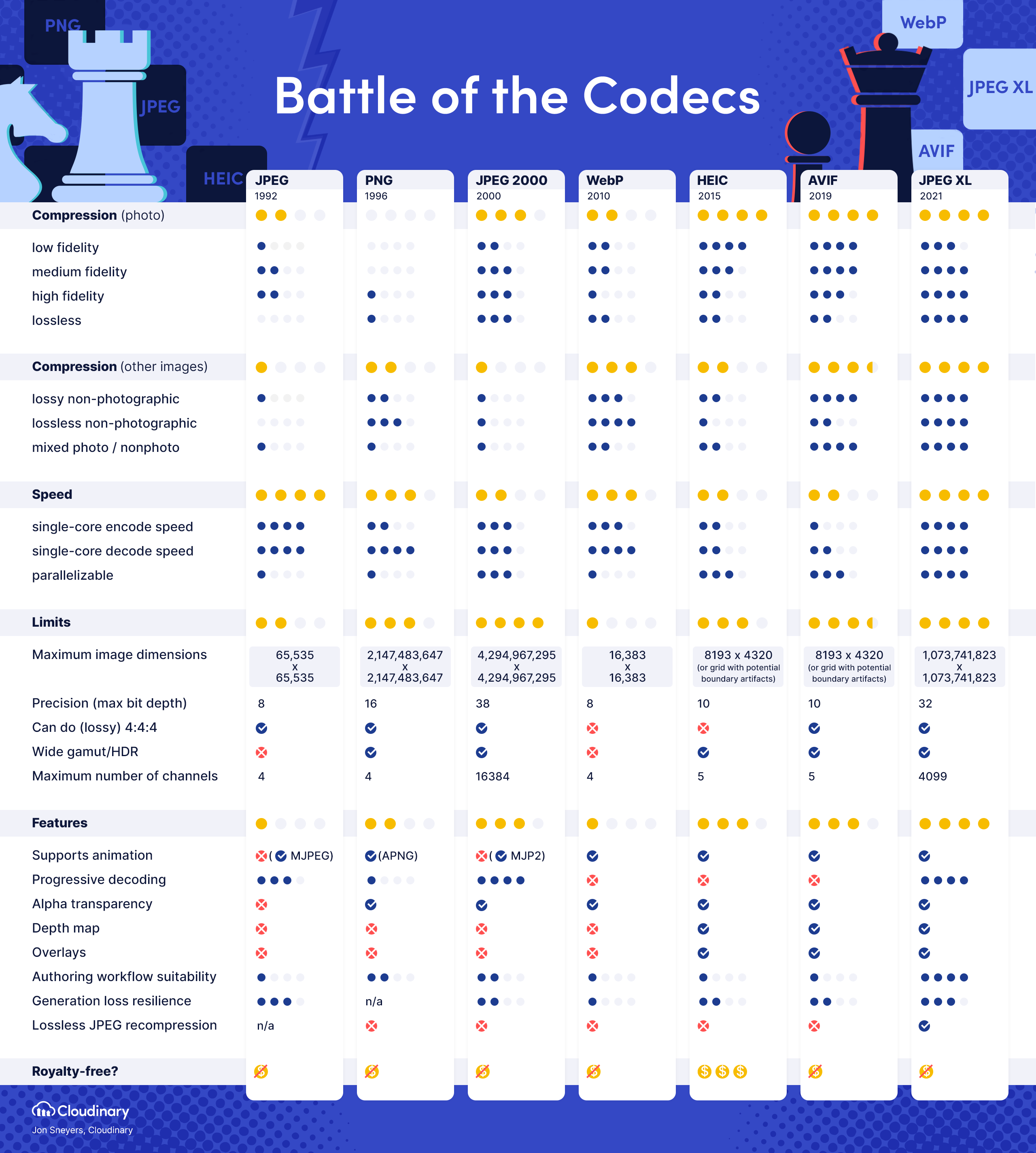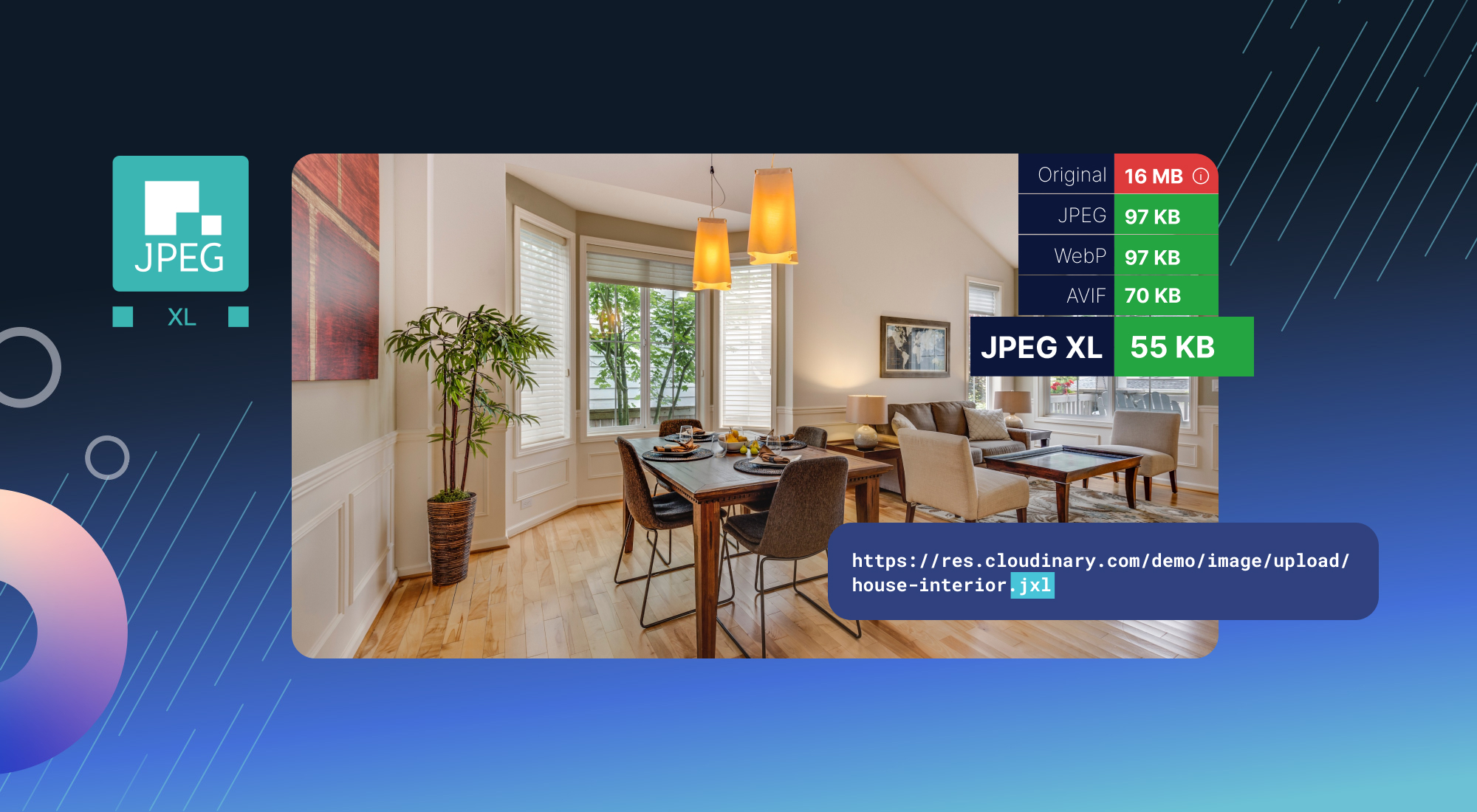What is the point of this format? How is it any better than png or webp? Do we really need yet another format? I mean 44k really isn’t that great of a savings in the example used.
A shortlist:
- it has the best lossy image compression (not counting extremely low bitrate images, where AVIF starts to win)
- it can losslessly recompress JPEGs for a free 20% space savings - no image quality loss
- it supports parallel decoding for extra speed
- it supports progressive decoding (viewing a lower quality version of the image while it loads), unlike WebP/AVIF which just “pop up” when you’ve downloaded the whole thing
- it supports lossless
- it compresses lossless extremely well (notably unlike AVIF and PNG which fall on their face with lossless compression)
- it supports animation (though AVIF is generally a better format for animation, because it’s based on a proper video codec)
- it supports HDR
- it has a very strong resilience against generation loss (the classic “JPEG degradation” of resaving images)
- it is royalty-free
- it otherwise has roughly every image format feature we’ve ever thought of included in its spec
If JXL is not the next image format then we will never ever get rid of JPEG and PNG. There has never been a more obviously superior image format in history.
This might help: Image format comparison table

I think you forgot a pretty crucial point, that it is also royalty free. Royalty would be a huge problem.
I have yet to see a general royalty free image format as feature complete and up to date as IFF was for the Amiga back in 1985. From your list, Jpeg XL would finally even surpass that. As a very feature complete format improving on at least 3 formats (GIF PNG JPG)while wrapping them into 1. The only thing missing, is to become universally supported.
I wonder how the Chrome team managed to test it so poorly they claimed it wasn’t worth it? Just the versatility alone should make it a no-brainer.
I think you forgot a pretty crucial point, that it is also royalty free.
I’ll go back and add it - there’s a lot of great stuff that I didn’t mention just for brevity. The biggest royalty concern is HEIC atm, which is basically a nonstarter. I’m not sure how the licensing on the other free formats compares against JXL.
I wonder how the Chrome team managed to test it so poorly they claimed it wasn’t worth it? Just the versatility alone should make it a no-brainer.
Make no mistake, it was a political killing. They didn’t kill it because of perceived performance, they killed it ahead of their public benchmarks because of “lack of interest”. Their cited lack of interest was determined after only a few months of the format going live behind opt-in experimental flags, and once they made their original decision, just about every large tech company spoke up in favor of JXL against Google’s decision on their bugtracker, including Adobe, Intel, Nvidia, Facebook, Shopify, and Flickr. Google still plugged their ears and pretended no one was interested.
Google is trying to push WebP (2.0?) and AVIF, and using their browser marketshare to kill JXL and make that happen. Why they went through all this trouble to kill a format that they themselves co-developed, I really have no idea. I follow JXL relatively closely and I still am not 100% sure why they went through with this. All I know is that the decision was politically-motivated, and without applying political/ecosystem pressure they’re not going to change their minds with data.
Edit: by the way, the last few comments still trickling in on that bugtracker are a great read, especially #406. #406 reads so similarly to my comment I’m surprised I didn’t write it, haha.
It’s very slow on high compression profiles though, and consumes a lot of resources.
You don’t need to use the high compression profiles to get good performance though. If you have a usecase where you are resource limited you should stick to effort levels 5-7 for very little loss in quality, or even 3-4 for lightning quick speed (the default is effort 7). Reference this benchmark against AVIF for effort values vs. speed (SSIMULACRA 2 is a deterministic psychovisual metric - higher is better).
Also, an important consideration in this realm is that JXL makes really clever use of variable-DCT (how big a chunk is) and adaptive quantization (what quality should be used for that chunk), allowing “quality levels” that you specify to be much more visually consistent across every image, instead of other codecs that make some images look bad at quality level 90 and some images look good at level 70. This allows you to select a consistent quality level and lower your encoding effort to compensate, instead of needing to always drive a high quality+effort level to account for every region in a picture looking good.
(If you want a slightly deeper dive into JXL’s performance, this is a concise post on various metrics)
I tried getting benefit from the format by recompressing PNGs at some point and it just seemed worthless due to reasons I listed in my comment.
With effort level 7 you should be getting images roughly 2/3’s of the size of the original PNG on average (assuming the PNG is already properly optimized). I would try again with at least effort levels 3, 4, 5, and 7. Also consider that PNGs need very expensive CPU time to properly compress them, using a tool like oxipng.
What sort of balance are you looking for with regards to filesize and encode time? At the very least, effort levels 1 through 3 will probably still give you better results than PNG while being ridiculously quick, so there shouldn’t be any configuration where PNG is a better choice than JXL with regards to speed.
Graph conveniently omits hardware support, where avif (av1) is supported across the board
No one uses hardware decoding for images - it’s just not a good fit for the reality of how we use images. Images are small and easy to decode, whereas starting up a hardware decoder takes a non-trivial amount of time. Additionally, GPU decoders only work single-threaded, so each image would have to be decoded one by one, instead of all at once like with CPU decoding. This was already attempted with VP8/WebP and they gave up trying to make it any good. Videos are good candidates for hardware decoding since they’re large and you’re only looking at one at a time.
If you have benchmarks or some proof showing otherwise by all means post here.
JPEG XL provides comparable image quality to ordinary JPEG compression at around 80% of the file size. It also supports lossless encoding at smaller sizes than PNG, and can handle layers, transparency and CMYK, so in principle it could conveniently replace almost every existing raster image format.
The article discusses how it’s better than webp. Specifically, it’s much better at both compression ratios and performance, at all quality levels. WebP has problems where the compression falls off due to being locked to yuv420
So I agree with your sentiment for the most part. Mainly, it’s frustrating to see all of these new image standards come out which somehow compete with each other due to lack of browser support.
That said 44k isn’t peanuts. That’s a huge reduction, especially on lower end connection speeds.




